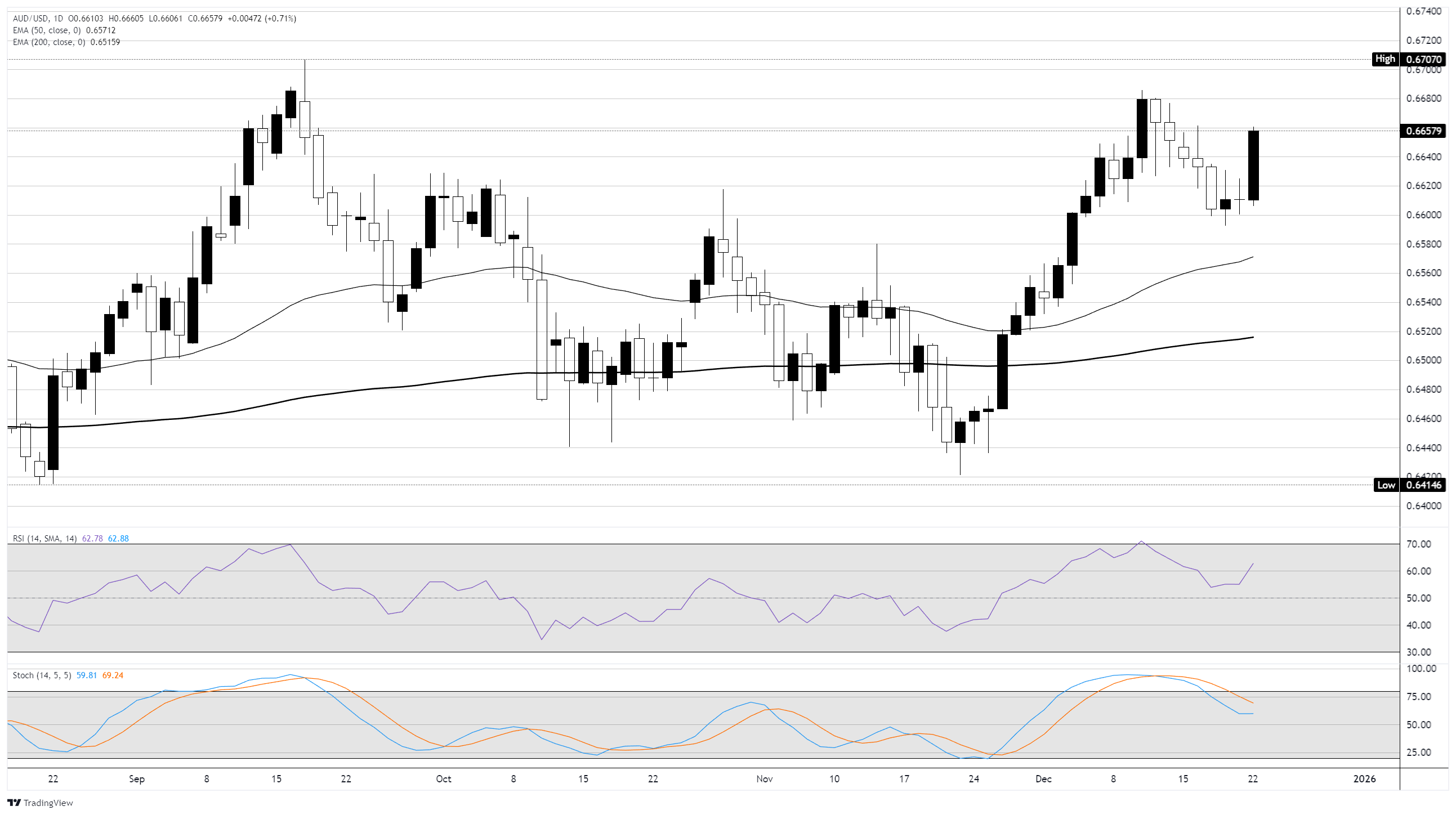AUD/USD bounces on fresh Greenback weakness
- AUD/USD heads into Tuesday markets on the high side.
- Global markets are winding down for the holiday shutdown.
- The Aussie caught a much-needed boost from a widely-declining US Dollar.
AUD/USD drove higher on Monday, climbing back into the 0.6660 region following an extended near-term decline. The Australian Dollar (AUD) took a lifeline thrown by broad-market Greenback flows that see the safe-haven US Dollar (USD) on the retreat heading into the holiday shutdown.
Global markets will be going dark early this week, with major exchanges shuttered as early as late Wednesday as investors take the holidays off. The Reserve Bank of Australia’s (RBA) latest rate call meeting minutes will drop early on Tuesday, giving Aussie traders a look into where the RBA is steering the interest rate ship.
Despite a near-term walkback, the Aussie traded into 14-month highs as recently as the week before, putting pressure on Australian businesses. The RBA is broadly expected to raise interest rates at least twice in 2026, putting a firm floor under the AUD as the US Federal Reserve (Fed) faces an accelerating pace of interest rate cuts moving forward over the next year or two.
US Gross Domestic Product (GDP) growth figures are also due on Tuesday, and are expected to show a general decline in headline growth during the third quarter. Q3 US GDP is expected to cool to 3.2% QoQ compared to the previous quarter’s 3.8% print.
AUD/USD daily chart

Australian Dollar FAQs
One of the most significant factors for the Australian Dollar (AUD) is the level of interest rates set by the Reserve Bank of Australia (RBA). Because Australia is a resource-rich country another key driver is the price of its biggest export, Iron Ore. The health of the Chinese economy, its largest trading partner, is a factor, as well as inflation in Australia, its growth rate and Trade Balance. Market sentiment – whether investors are taking on more risky assets (risk-on) or seeking safe-havens (risk-off) – is also a factor, with risk-on positive for AUD.
The Reserve Bank of Australia (RBA) influences the Australian Dollar (AUD) by setting the level of interest rates that Australian banks can lend to each other. This influences the level of interest rates in the economy as a whole. The main goal of the RBA is to maintain a stable inflation rate of 2-3% by adjusting interest rates up or down. Relatively high interest rates compared to other major central banks support the AUD, and the opposite for relatively low. The RBA can also use quantitative easing and tightening to influence credit conditions, with the former AUD-negative and the latter AUD-positive.
China is Australia’s largest trading partner so the health of the Chinese economy is a major influence on the value of the Australian Dollar (AUD). When the Chinese economy is doing well it purchases more raw materials, goods and services from Australia, lifting demand for the AUD, and pushing up its value. The opposite is the case when the Chinese economy is not growing as fast as expected. Positive or negative surprises in Chinese growth data, therefore, often have a direct impact on the Australian Dollar and its pairs.
Iron Ore is Australia’s largest export, accounting for $118 billion a year according to data from 2021, with China as its primary destination. The price of Iron Ore, therefore, can be a driver of the Australian Dollar. Generally, if the price of Iron Ore rises, AUD also goes up, as aggregate demand for the currency increases. The opposite is the case if the price of Iron Ore falls. Higher Iron Ore prices also tend to result in a greater likelihood of a positive Trade Balance for Australia, which is also positive of the AUD.
The Trade Balance, which is the difference between what a country earns from its exports versus what it pays for its imports, is another factor that can influence the value of the Australian Dollar. If Australia produces highly sought after exports, then its currency will gain in value purely from the surplus demand created from foreign buyers seeking to purchase its exports versus what it spends to purchase imports. Therefore, a positive net Trade Balance strengthens the AUD, with the opposite effect if the Trade Balance is negative.







